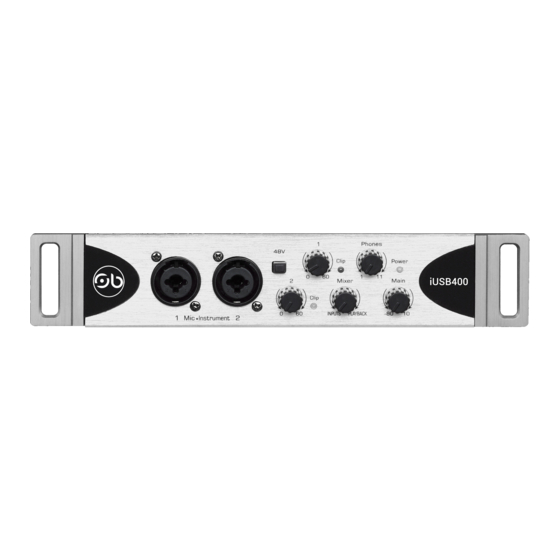
Resumen de contenidos para Soundbarrier iUSB400
- Página 1 2X2 USB Audio Interface with Preamplifier, Phantom Power, and Instrument Input INSTRUCTION MANUAL MANUAL DE INSTRUCCIONES VERSION 1.0...
-
Página 2: Explanation Of Graphical Symbols
Explanation of Graphical Symbols The lightning flash with arrowhead symbol within an equilateral triangle is intended to alert the user to the presence of uninsulated CAUTION VORSICHT ‘dangerous voltage’ within the product’s enclosure that may be of BEFORE OPENING VOR DEM OFFNEN sufficient magnitude to constitute a risk of electric shock to persons. - Página 3 WARNING Always follow the basic precautions listed below to avoid the possibility of physical injury to you or others, or damage to the device or other property. These precautions include, but are not limited to, the following: Power supply/Power cord Connections •Remove the electric plug from the outlet when the devices is not •Before connecting the device to other devices, turn off the power for...
-
Página 4: Explicación De Los Símbolos Gráficos
Explicación de los símbolos gráficos El símbolo del rayo con punta de flecha dentro de un triángulo equilátero pretende alertar al usuario de la presencia de "voltaje peligroso" no aislado dentro del envolvente del producto que puede ser de una magnitud suficiente para constituir un riesgo de descarga eléctrica para las personas. - Página 5 AVISO Siga siempre las precauciones básicas que se enumeran a continuación para evitar la posibilidad de lesiones físicas a usted u otras personas o daños al dispositivo u otros bienes. Estas precauciones incluyen, entre otras, las siguientes: Fuente de alimentación / cable de alimentación Conexiones •...
-
Página 6: Hardware Features
Throughout this manual you will find Power User Tips that can quickly make you an IUSB400 expert. In addition to the Power User Tips, you will find an assortment of audio tutorials at the back of this manual. These tutorials cover everything from microphone placement to equalizer and compression-setting suggestions. -
Página 7: Front-Panel Connections And Controls
D.I. box, which should then be connected to the mic input rather than directly to an instrument input. Plugging a line-level source into the instrument inputs on the front of the IUSB400 not only risks damage to... -
Página 8: Rear-Panel Connections
Please note: As with any audio input device, plugging in a microphone or an instrument, or turning phantom power on or off, will create a momentary spike in the audio output of your IUSB400. Because of this, we highly recommend that you turn down the main output level and channel trims before changing connections or turning phantom power on or off. - Página 9 It’s important to ensure that your MIDI data is correctly sent and received by the appropriate hardware or software devices. If the devices generate audio, you may also need to return the audio to an IUSB400 input channel. Please consult the User Manuals of your MIDI devices for help with MIDI setup and usage.
- Página 10 A faster processor and more RAM can reduce signal latency (delay) and improve overall performance. You can use your Sound Barrier iUSB400 with almost any audio-recording application that supports Core Audio or ASIO. Please consult the documentation that came with your audio application for specific instructions on how to select a compatible driver as the audio-device driver for your software.
- Página 11 Below are basic driver-setup instructions for a few popular audio applications. Ableton Live 1. Launch Ableton Live. 2. Go to Options | Preferences | Audio. 3. Choose Driver Type: Asio | Audio Device: ASIO PRES0N** AUDIOB** U**96. 4. Go to Input Config: Enable and select the desired Input channels. 5.
- Página 12 Specifications Microphone Preamp Type: XLR Female, Balanced Frequency Response (±3.0 dB) 20 Hz to 20 kHz Input Impedance (Balanced) 1200Ω THD+N (unwtd, 1 kHz @ +4 dBu Output, Unity Gain) < 0.008% S/N Ratio (Unity Gain, Ref. = +4 dBu, 20 Hz to 22 kHz) > 95 dB Common Mode Rejection Ratio (1 kHz, 55 dB Gain) >...
- Página 13 www.soundbarrier.com...
